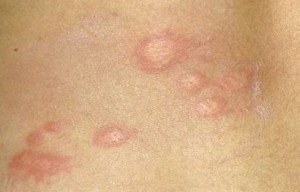A wide variety of skin disorders and inflammatory conditions can be collectively referred to by the term ‘rash’.
Various terms have been used by dermatologists to describe skin rashes, and as such the features and characteristics of a rash determine the term given. Skin rashes are explained and diagnosed on the basis of their color, density, size, tenderness, consistency, shape, warmth, etc.
Many skin disorders have a pattern of partiality to appear in specific body areas making it useful for rash diagnosis. Some common categories of skin rashes are:
- Noninfectious, common rashes that are localized to certain regions of the body
- Widespread rashes that affect large areas of the body skin
- Rashes caused due to bacterial or fungal infection
Even though most of the rashes are not dangerous and quickly resolve without treatment, it is advised that one should consult a doctor or a health care professional for proper evaluation and diagnosis of skin rashes.

Scaly patches of skin due to bacterial or fungal infection
When rashes appear due to infection, the most common agents for infection are fungus or bacteria. A variety of simple tests can confirm and classify the types of infections and skin rashes.
Fungal infections: Fungal infections are very common. Hence very often all scaly rashes are misdiagnosed and mistaken for fungal infections by the patients and by non-dermatologists. An individual with scaly patches on legs, arms or torso is more likely to have dermatitis or eczema. Calling it as a fungus or ringworm may not be the correct rash diagnosis. Similarly botanically related fungi can also cause skin rashes which normally affect folds of skin, such as skin under the breasts or groin. They appear fiery red, and have pustules on edges. Calling the yeast infection as eczema indicates incorrect rash diagnosis.
Fungus and yeast infections are not very contagious. Clean people with better personal hygienic are also affected by this infection. Treatment for fungal rashes is simple. The normal cases may be treated with antifungal creams available over the counter. Severe cases may require treatment with oral terbinafine.
Bacterial infections: Impetigo is the most common bacterial infection and is caused by strep germs. It is more common among children. Bacteria may cause either pustular or plaque-like skin eruptions that are painful. Oral antibiotics or topical antibiotic creams like mupirocin can heal the rash.
Rashes that affect a large section of body skin
The outbreak of such type of rashes is usually due to either viral or allergic causes.
Viral rash: Viral infections like herpes or shingles affect one part of the body. Viral rashes are symmetrical and wide spread. Patients with such type of rashes may not elicit other viral symptoms like sneezing, coughing or stomach disorder. Viral rashes vanish on their own within a few days, and the treatment is directed towards itch relief, if any exists.
Other rashes
- Hives or welts that come and disappear on its own within few hours.
- Heat rash is a skin irritation caused by increased sweating. It occurs in humid climate and is more common among children. It appears like a cluster of bumps or blisters that generally tends to form on the neck, chest and groin; in elbow folds and under the breasts.
Skin disorders can be an indication that there is another serious condition inside the body. *
Very latest post coming from our own blog
http://www.foodsupplementdigest.com/wheatgrass-juice-benefits/
Bacterial infections can affect pregnant women from implantation of the fertilized ovum through the time of delivery and peripartum period. They may also affect the fetus and newborn. Many women with these infections are asymptomatic, necessitating both a high degree of clinical awareness and adequate screening. `
Our new blog site
<,http://www.healthmedicinecentral.com/anxiety-symptoms-in-men/